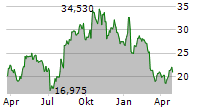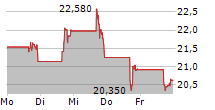FRIENDSWOOD, Texas, Nov. 14, 2025 (GLOBE NEWSWIRE) -- Castle Biosciences, Inc. (Nasdaq: CSTL), a company improving health through innovative tests that guide patient care, today announced new data demonstrating the clinical value of its DecisionDx-Melanoma test in improving sentinel lymph node (SLN) biopsy (SLNB) decision making and enhancing recurrence risk prediction in patients with cutaneous melanoma (CM). The data will be featured in two oral presentations at the 2nd European Congress on Dermato-Oncology (ECDO), taking place Nov. 17-18, 2025, in Paris, France.
"DecisionDx-Melanoma continues to demonstrate strong performance in helping physicians make more informed, risk-aligned decisions about sentinel lymph node biopsy," said J. Michael Guenther, M.D., presenting author for both studies and surgical oncologist at St. Elizabeth Physicians in Edgewood, Kentucky. "These new data reinforce how the test can accurately identify patients with a low likelihood of sentinel node positivity who can safely consider forgoing the procedure, as well as those who remain at risk of recurrence even when their node is negative. Together, the findings highlight how DecisionDx-Melanoma can support more precise surgical planning and ongoing patient management."
SLNB helps stage patients with CM by determining whether cancer cells have spread beyond the primary tumor site, information that can help guide prognosis and treatment decisions. Current guidelines recommend considering SLNB when the estimated probability of a positive node exceeds 5%. Traditionally, that estimate is driven primarily by Breslow thickness and ulceration, which are key pathologic components used in staging. However, up to 88% of SLNB procedures yield negative results, and as many as 16% of SLN-negative patients still experience disease recurrence within five years, underscoring the need for tools that better identify who is likely to have a positive node and who may remain at risk despite a negative result.1,2
DecisionDx-Melanoma helps address this clinical challenge. The test uses tumor biology to generate a personalized class result from an independently validated gene-expression-profiling (GEP) score. The report also includes two distinct integrated algorithms: i31-SLNB, which predicts likelihood of SLN positivity, and i31-ROR, which assesses recurrence risk. By combining the GEP score with select clinicopathologic features, DecisionDx-Melanoma provides a comprehensive, personalized risk assessment to support more informed patient management decisions, such as consideration of SLNB.
Guenther will present both oral presentations at ECDO 2025:
Abstract 153: The i31-SLNB for cutaneous melanoma outperforms the clinicopathologic-only MIA nomogram at identifying patients at low risk of having a positive sentinel lymph node biopsy: A prospective, multicenter study
- Session 3: Short Presentations Young Investigators
- Session Date: Monday, November 17
- Session Time: 11:45 a.m.-12:15 p.m. Central European Time
- Summary: New data from this prospective, multicenter study show that DecisionDx-Melanoma's i31-SLNB algorithm more precisely predicts SLN positivity compared to the Melanoma Institute Australia (MIA) nomogram, which estimates a patient's likelihood of SLN positivity based solely on clinical and pathologic risk factors. The i31-SLNB demonstrated significantly greater discriminative performance than the MIA nomogram (AUC=0.74 vs. 0.61; p=0.001), reflecting superior sensitivity and specificity, and more accurately identified patients at both low (<5%) and high (>10%) risk of SLN positivity. Patients predicted by the i31-SLNB to have less than 5% risk had an actual SLN positivity rate of only 2.6%, compared to 5.8% in patients classified as low risk by the MIA tool. These findings show that the i31-SLNB more accurately identifies patients who could safely avoid the procedure, while the MIA nomogram's low-risk group exceeded the 5% threshold. Conversely, among patients predicted to have greater than 10% risk, the actual SLN positivity rate was 21.4% with the i31-SLNB versus 13.8% with MIA, demonstrating that the i31-SLNB more effectively identifies those truly at higher risk. By integrating tumor biology with clinical and pathologic features, the i31-SLNB is designed to provide critical guidance to help physicians determine which patients should undergo, and which may safely forgo, an SLNB procedure. This personalized approach can help reduce unnecessary surgeries and associated risks while supporting more informed, risk-aligned care for patients with melanoma.
Abstract 140: The 31-gene expression profile is an independent predictor of poor 5-year outcomes and identifies high-risk cutaneous melanoma in patients with a negative sentinel lymph node
- Session 8: Short Presentations Young Investigators
- Session Date: Tuesday, November 18
- Session Time: 1:30-2:15 p.m. Central European Time
- Summary: New data from a multicenter study of 810 patients with early-stage (stage I-II), SLN-negative CM, meaning no cancer cells were found in the lymph node, show that the DecisionDx-Melanoma test (31-GEP) is an independent predictor of recurrence and significantly improves risk prediction beyond American Joint Committee on Cancer (AJCC) staging alone. Patients with a high-risk (Class 2B) test result had markedly lower five-year recurrence-free survival than those with Class 1A or Class 1B/2A results (p<0.001), and adding the DecisionDx-Melanoma test results to AJCC staging significantly increased prognostic accuracy (ANOVA ?²=7.75, p=0.02). By combining the biologic information of the tumor with traditional staging, DecisionDx-Melanoma is designed to enhance five-year prognostic accuracy in SLN-negative patients and potentially provide additional clarity for identifying those at higher risk of recurrence. These findings support the test's potential to help clinicians make more risk-aligned therapeutic decisions and tailor follow-up care according to a patient's individual risk.
Electronic posters associated with both oral presentations will also be available to view throughout the conference.
About DecisionDx-Melanoma
DecisionDx-Melanoma is a gene expression profile (GEP) test designed to analyze tumor biology to deliver a personalized risk assessment for patients with stage I-III cutaneous melanoma, enhancing risk stratification beyond American Joint Committee on Cancer (AJCC) staging alone. By combining molecular insights with select clinicopathologic features, the test provides two distinct outputs: a personalized risk of sentinel lymph node (SLN) positivity and a personalized risk of recurrence and/or metastasis. This clinically actionable information is designed to help guide risk-aligned patient management decisions, including SLN biopsy consideration, follow-up intensity, imaging and referrals.
DecisionDx-Melanoma is supported by more than 50 peer-reviewed publications, including prospective studies and meta-analyses, and was developed in collaboration with more than 100 leading U.S. institutions. The test has been clinically validated in more than 10,000 patient samples, ordered more than 220,000 times since launch, and has been shown to be associated with improved patient survival. Learn more at www.CastleBiosciences.com.
About Castle Biosciences
Castle Biosciences (Nasdaq: CSTL) is a leading diagnostics company improving health through innovative tests that guide patient care. With a primary focus in dermatologic and gastroenterological disease, we develop personalized, clinically actionable solutions that help improve disease management and patient outcomes.
We put people first-empowering patients and clinicians and informing care decisions through rigorous science and advanced molecular tests that support more confident treatment planning. To learn more, visit www.CastleBiosciences.com and connect with us on LinkedIn, Instagram, Facebook and X.?
DecisionDx-Melanoma, DecisionDx-CMSeq, i31-SLNB, i31-ROR, DecisionDx-SCC, MyPath Melanoma, AdvanceAD-Tx, TissueCypher, DecisionDx-UM, DecisionDx-PRAME and DecisionDx-UMSeq are trademarks of Castle Biosciences, Inc.
Forward-Looking Statements
This press release contains forward-looking statements within the meaning of Section 27A of the Securities Act of 1933, as amended, and Section 21E of the Securities Exchange Act of 1934, as amended, which are subject to the "safe harbor" created by those sections. These forward-looking statements include, but are not limited to, statements concerning: DecisionDx-Melanoma's ability to provide (i) comprehensive, personalized results to guide risk-aligned management decisions for patients diagnosed with cutaneous melanoma, and (ii) precise and clinically meaningful risk stratification; DecisionDx-Melanoma's performance versus other tests currently on the market;. The words "can," "may" and similar expressions are intended to identify forward-looking statements, although not all forward-looking statements contain these identifying words. We may not actually achieve the plans, intentions or expectations disclosed in our forward-looking statements, and you should not place undue reliance on our forward-looking statements. Actual results or events could differ materially from the plans, intentions and expectations disclosed in the forward-looking statements that we make. These forward-looking statements involve risks and uncertainties that could cause our actual results to differ materially from those in the forward-looking statements, including, without limitation: subsequent study or trial results and findings may contradict earlier study or trial results and findings or may not support the results obtained in these studies, including with respect to the discussion of our tests in this press release; actual application of our tests may not provide the aforementioned benefits to patients; and the risks set forth under the heading "Risk Factors" in our Annual Report on Form 10-K for the year ended December 31, 2024, and our Quarterly Report on Form 10-Q for the quarter ended September 30, 2025, each as filed with the SEC, and in our other filings with the SEC. The forward-looking statements are applicable only as of the date on which they are made, and we do not assume any obligation to update any forward-looking statements, except as may be required by law.
- Chen J, Xu Y, Zhou Y, Wang Y, Zhu H, Shi Y. Prognostic role of sentinel lymph node biopsy for patients with cutaneous melanoma: A retrospective study of surveillance, epidemiology, and end-result population-based data. Oncotarget 2016;7(29):45671-7
- Jones EL, Jones TS, Pearlman NW, et al. Long-term follow-up and survival of patients following a recurrence of melanoma after a negative sentinel lymph node biopsy result. JAMA Surg. 2013;148(5):456-461. doi:10.1001/jamasurg.2013.1335
Investor Contact:
Camilla Zuckero
czuckero@castlebiosciences.com
Media Contact:
Allison Marshall
amarshall@castlebiosciences.com



